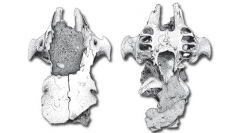

 Geodiversitas
36 (2) - Pages 283-310
Geodiversitas
36 (2) - Pages 283-310New remains of Hypolagus balearicus Quintana, Bover, Alcover, Agustí & Bailon, 2010 from Ses Fontanelles (Eivissa) gives new information concerning this Early Pliocene endemic leporid from Eivissa and Mallorca (Balearic Islands, Western Mediterranean sea). The body mass estimated for H. balearicus ranges from 1.3 to 2.7 kg, which is small in comparison to other species of the same genus. The cranium of H. balearicus is proportionally short and has relatively smaller orbits than Oryctolagus cuniculus (Linnaeus, 1758). Remarkable in the usually conservative (in leporids) postcranial skeleton is the particular morphology of the elbow (with crests and pits with a soft outline) and its length in relation to the length and the transversal diameter of the humerus, which yields similar proportions to those of the Amami rabbit Pentalagus furnessi (Stone, 1900) from Amami-Ohshima Island and Tokuno-Shima Island (Japan). In contrast, the diaphysis of the ulna shows a robustness comparable to that observed in some mainland leporids of the genus Pronolagus Lyon, 1904 or Caprolagus Blyth, 1845. In light of the rather small size of the sample and the information yielded, two alternative hypotheses are proposed to explain the particular traits of the forelimb of H. balearicus: a) it is a leporid evolved under conditions of insularity; or b) the traits reflect an adaptation to particular ecological conditions, not necessarily linked to an island in the classical sense of the word. The observed differences between this species (morphology of p3 as well as particular traits of the forelimb) and other species of the genus Hypolagus Dice, 1917 are likely indicative of the particular taxonomical position of this taxon.
Messinian regressive episode, Early Pliocene, early insular faunas, karstic deposit, colonization process, biogeographic model.